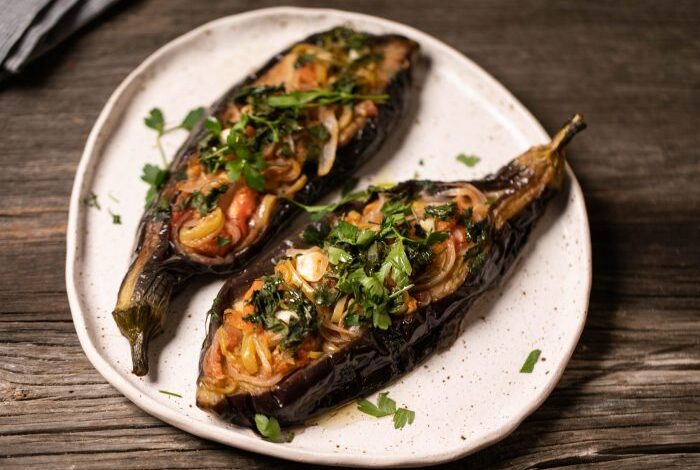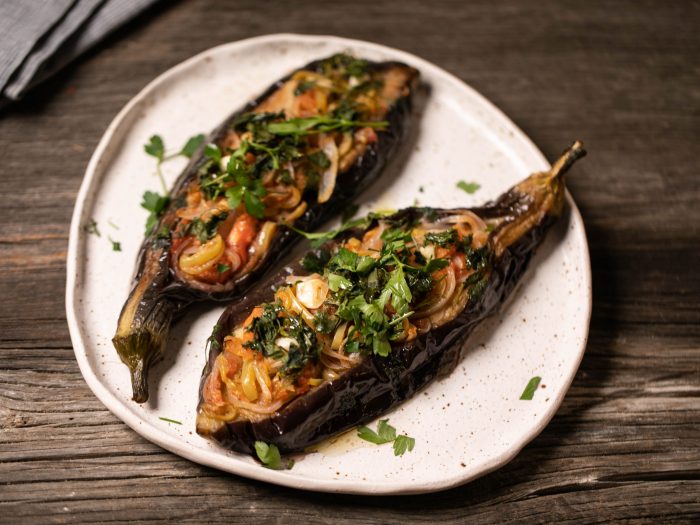
Armenian Stuffed Eggplant Imam Bayildi: A Culinary Journey
Armenian Stuffed Eggplant Imam Bayildi, a dish with a name that translates to “the Imam Fainted,” is a testament to the rich culinary heritage of Armenia. This flavorful eggplant dish, filled with a savory mixture of herbs, spices, and often ground meat, is a staple in Armenian cuisine, showcasing the country’s unique blend of Ottoman and Eastern European influences.
The origins of Imam Bayildi are shrouded in culinary folklore, with tales suggesting its creation in Ottoman kitchens. However, the Armenian version of this dish boasts distinct flavors and ingredients, reflecting the region’s unique culinary traditions. The dish’s name, “Imam Bayildi,” is believed to have originated from the intense aroma and deliciousness of the dish, said to have caused an imam to faint upon tasting it.
History and Origins of Imam Bayildi
Imam Bayildi, a beloved dish of stuffed eggplant, holds a rich history deeply intertwined with the culinary traditions of the Ottoman Empire. Its origins can be traced back to the 16th century, during the reign of the Ottoman Sultan Suleiman the Magnificent.
The dish’s name, “Imam Bayildi,” which translates to “the Imam fainted,” is a testament to its irresistible flavor and aroma.
Etymology of “Imam Bayildi”
The exact etymology of the name is shrouded in some mystery. However, there are several compelling theories that offer insights into its origins. One widely accepted theory suggests that the name arose from a story about an Imam who fainted after tasting the dish.
This story is believed to have originated in the kitchens of the Ottoman Palace, where the Imam was a frequent guest. Another theory suggests that the name was inspired by the dish’s rich and aromatic flavors, which were so intense that they could potentially make someone faint.
Variations of Imam Bayildi Across Regions and Cultures
Imam Bayildi, despite its origins in Ottoman cuisine, has evolved over the centuries, resulting in variations across different regions and cultures. The basic recipe typically involves stuffing eggplants with a mixture of rice, onions, tomatoes, and spices. However, variations can be seen in the choice of spices, the addition of other ingredients, and the cooking methods.In Turkey, Imam Bayildi is often prepared with a combination of spices such as cumin, cinnamon, and paprika.
The dish is typically cooked in a tomato-based sauce, giving it a rich and flavorful taste. In the Balkans, Imam Bayildi is often prepared with a more savory filling, including ground meat, pine nuts, and herbs. The dish is often baked in the oven, resulting in a tender and flavorful eggplant.
In Greece, a similar dish known as “Imam Bayildi” is prepared with a filling of rice, onions, tomatoes, and cinnamon. The dish is often served with a dollop of yogurt, adding a creamy and tangy element to the flavors.
Ingredients and Preparation of Armenian Stuffed Eggplant Imam Bayildi
The Armenian version of Imam Bayildi, while sharing its core ingredients with the Turkish original, adds its own unique twist with the inclusion of fresh herbs and a distinct spice blend. This results in a dish that is both comforting and flavorful, showcasing the culinary traditions of Armenia.
Ingredients
The key ingredients for Armenian Imam Bayildi include:
- Eggplants: The foundation of the dish, they are typically chosen for their size and firmness, ensuring they hold their shape during roasting and stuffing.
- Olive Oil: A generous amount is used for roasting the eggplants, creating a rich and flavorful base for the dish.
- Onions: Finely chopped and sautéed in olive oil, they provide a sweet and savory base for the filling.
- Tomatoes: Diced and added to the filling, they add a tangy and juicy element.
- Rice: Used as a binder and filler, it adds a comforting texture and absorbs the flavors of the other ingredients.
- Fresh Herbs: A key element in the Armenian version, herbs such as parsley, dill, mint, and cilantro are chopped and added to the filling, providing a vibrant and refreshing aroma.
- Spices: Armenian Imam Bayildi is typically seasoned with a blend of spices including cumin, coriander, paprika, and black pepper, adding warmth and depth to the dish.
- Salt and Pepper: These are used to taste and enhance the overall flavor profile.
Preparation
The preparation of Armenian Imam Bayildi involves several steps:
- Roasting the Eggplants: The eggplants are first roasted in the oven or over an open flame until their skin is charred and their flesh is tender. This roasting process is crucial for developing a smoky flavor and softening the eggplant, making it easier to scoop out and stuff.
- Preparing the Filling: While the eggplants are roasting, the filling is prepared. Onions are sautéed in olive oil until translucent, then tomatoes, rice, herbs, and spices are added and cooked until the rice is slightly softened. The filling is seasoned with salt and pepper to taste.
- Stuffing the Eggplants: Once the eggplants are cool enough to handle, they are sliced lengthwise and the flesh is scooped out, leaving a hollow shell. The scooped-out eggplant flesh is then added to the filling, and the mixture is thoroughly combined. The filling is then spooned back into the eggplant shells.
- Baking the Stuffed Eggplants: The stuffed eggplants are arranged in a baking dish, drizzled with olive oil, and baked in the oven until the filling is heated through and the eggplants are tender. The baking process allows the flavors to meld and the rice to absorb the juices from the filling.
The Role of Spices and Herbs
The spices and herbs used in Armenian Imam Bayildi play a crucial role in creating its unique flavor profile.
“The combination of cumin, coriander, paprika, and black pepper adds a warm and earthy depth to the dish, while the fresh herbs, such as parsley, dill, mint, and cilantro, provide a vibrant and refreshing counterpoint.”
These flavors work in harmony with the sweetness of the onions, the tanginess of the tomatoes, and the creamy texture of the eggplant, creating a truly memorable culinary experience.
Cultural Significance and Traditions

Imam Bayildi, a beloved dish in Armenian cuisine, transcends its status as a culinary delight to become a symbol of cultural heritage and tradition. This dish, with its rich history and flavorful profile, holds a special place in Armenian homes and celebrations.
The Importance of Imam Bayildi in Armenian Cuisine
Imam Bayildi is a staple in Armenian cuisine, often served during special occasions and family gatherings. Its presence on the table signifies a celebration of shared history, culinary traditions, and the joy of coming together. The dish is a testament to the resilience and resourcefulness of the Armenian people, who have passed down their culinary legacy through generations.
Traditions Associated with Imam Bayildi
The preparation and consumption of Imam Bayildi are often accompanied by specific traditions and stories that have been passed down through generations. These traditions reflect the deep cultural significance of this dish.
- In some Armenian families, the preparation of Imam Bayildi is a collaborative effort, with different family members contributing to the process. This communal activity strengthens family bonds and fosters a sense of shared heritage.
- The dish is often served with a side of yogurt or sour cream, which helps to balance the richness of the eggplant and create a harmonious flavor profile. This pairing represents the balance and harmony that Armenians strive for in their lives.
- Some families have specific rituals associated with the consumption of Imam Bayildi, such as reciting prayers or sharing stories before enjoying the meal. These rituals add a spiritual dimension to the culinary experience and connect generations through shared traditions.
Cultural Exchange and Influence
The culinary landscape of Armenia has been shaped by a rich history of cultural exchange and influence. Imam Bayildi, with its Ottoman origins, reflects the historical interactions between Armenian and Ottoman culinary practices. This exchange has resulted in a unique culinary tradition that blends elements of both cultures.
Armenian Influences on Imam Bayildi
Armenian culinary traditions have contributed to the evolution of Imam Bayildi. The use of specific spices and herbs, such as Armenian sumac, adds a distinct flavor profile to the dish. The inclusion of dried fruits and nuts, common ingredients in Armenian cuisine, adds a layer of sweetness and texture.
These adaptations reflect the creative and innovative spirit of Armenian cooks, who have adapted and refined the dish to suit their own tastes and traditions.
Variations and Adaptations: Armenian Stuffed Eggplant Imam Bayildi
The beauty of Armenian stuffed eggplant Imam Bayildi lies in its adaptability. This traditional dish has evolved over time, with regional variations and personal preferences shaping its diverse forms. Furthermore, the recipe can be easily modified to suit dietary needs and preferences, making it accessible to a wider audience.
Regional Variations
Regional variations in Armenian stuffed eggplant Imam Bayildi primarily involve the choice of ingredients and the way they are combined. For instance, in some regions, the filling might include additional ingredients like chopped walnuts or dried fruits, adding a touch of sweetness and nuttiness to the dish.
In other regions, the filling might be seasoned with different herbs and spices, creating unique flavor profiles. Additionally, the eggplant itself might be prepared differently, sometimes being roasted or grilled instead of fried, adding a distinct smoky flavor.
Adaptations for Dietary Preferences
Armenian stuffed eggplant Imam Bayildi can be adapted to suit various dietary needs and preferences. For vegetarians, the traditional meat filling can be replaced with a variety of plant-based alternatives, such as lentils, chickpeas, or a mixture of vegetables.
Vegan versions can be created by using plant-based milk and butter substitutes, as well as ensuring that all ingredients are vegan-friendly. For those who prefer a lighter version, the amount of oil used in the recipe can be reduced, or the eggplant can be baked instead of fried.
Modern Interpretations, Armenian stuffed eggplant imam bayildi
Modern chefs have embraced the versatility of Armenian stuffed eggplant Imam Bayildi, incorporating innovative techniques and ingredients to create unique and contemporary versions of the dish. For example, some chefs might use a variety of colorful bell peppers instead of traditional eggplant, adding a vibrant visual appeal.
Others might incorporate exotic spices and herbs, such as saffron or cardamom, to create a more complex and aromatic flavor profile. The dish can also be presented in a more modern and elegant manner, using decorative plating techniques and garnishes.
Nutritional Value and Health Benefits
Armenian stuffed eggplant Imam Bayildi is not only a delicious and flavorful dish but also a nutritious meal that can contribute to a healthy diet. The combination of eggplant, vegetables, herbs, and spices offers a variety of vitamins, minerals, and antioxidants.
Nutritional Profile of Imam Bayildi
The nutritional profile of Imam Bayildi varies depending on the specific ingredients and preparation methods. However, in general, this dish is a good source of fiber, vitamins, and minerals, including:
- Fiber:Eggplant is an excellent source of dietary fiber, which aids digestion, promotes satiety, and helps regulate blood sugar levels.
- Vitamin C:Tomatoes and bell peppers, common ingredients in Imam Bayildi, are rich in vitamin C, an antioxidant that supports immune function and collagen production.
- Potassium:Eggplant and tomatoes are good sources of potassium, an essential mineral that helps regulate blood pressure and muscle function.
- Vitamin A:Bell peppers and onions contribute vitamin A, which is crucial for vision, skin health, and immune function.
- Vitamin K:Spinach, often used in Imam Bayildi, is a rich source of vitamin K, which is essential for blood clotting and bone health.
Role of Ingredients in Promoting a Healthy Diet
The ingredients in Imam Bayildi play a significant role in promoting a healthy diet:
- Eggplant:Low in calories and rich in fiber, eggplant promotes satiety and helps manage weight. Its antioxidants may also contribute to reducing inflammation and protecting against certain diseases.
- Tomatoes:Tomatoes are packed with lycopene, a powerful antioxidant that may help reduce the risk of heart disease and certain cancers. They also provide vitamin C and potassium.
- Bell Peppers:Bell peppers are a good source of vitamins A and C, and their vibrant colors indicate their high antioxidant content, which may contribute to overall health.
- Onions:Onions contain quercetin, an antioxidant that may have anti-inflammatory and anti-cancer properties. They also provide fiber and vitamin C.
- Garlic:Garlic is known for its antimicrobial and anti-inflammatory properties. It may also help lower blood pressure and cholesterol levels.
Incorporating Imam Bayildi into a Balanced Meal Plan
Imam Bayildi can be easily incorporated into a balanced meal plan as a main course or side dish. Here are some suggestions:
- Main Course:Serve Imam Bayildi with a protein source like grilled chicken, fish, or tofu for a complete and satisfying meal.
- Side Dish:Pair Imam Bayildi with a grain like brown rice or quinoa for a balanced and nutritious meal.
- Vegetarian Option:For a vegetarian meal, serve Imam Bayildi with a side of lentil soup or a salad.
Pairing and Presentation

Armenian stuffed eggplant Imam Bayildi, with its rich and savory flavors, lends itself beautifully to a variety of pairings and presentation styles. Whether you’re serving it as a main course or a side dish, the right accompaniments and presentation can elevate the dining experience.
Beverage Pairings
The earthy and slightly sweet flavors of Imam Bayildi make it a versatile dish that can be paired with a range of beverages. Here are some suggestions:
- Red Wine:A light-bodied red wine like Pinot Noir or Beaujolais would complement the dish’s richness without overpowering its delicate flavors.
- White Wine:A crisp and dry white wine such as Sauvignon Blanc or Chardonnay would also be a good choice, especially if the eggplant is served with a tomato-based sauce.
- Rose Wine:For a lighter option, a dry rosé wine would provide a refreshing contrast to the dish’s savory notes.
- Beer:A light and refreshing beer like a Pilsner or a wheat beer would be a good accompaniment, especially if the dish is served with a yogurt sauce.
Side Dishes
To create a well-rounded meal, consider serving Imam Bayildi with a variety of side dishes that complement its flavors and textures. Here are some ideas:
- Rice Pilaf:A simple rice pilaf provides a neutral base for the dish’s bold flavors.
- Bulgur Wheat Salad:A refreshing bulgur wheat salad with herbs and vegetables would add a contrasting texture and flavor.
- Grilled Pita Bread:Warm pita bread can be used to scoop up the filling and sauce.
- Fresh Salad:A simple green salad with a light vinaigrette would provide a refreshing counterpoint to the rich flavors of the dish.
Presentation
The presentation of Imam Bayildi is just as important as its taste. Here are some tips for creating an aesthetically pleasing and appealing dish:
- Arrange the Eggplants:Arrange the stuffed eggplant halves in a visually appealing manner on a platter or individual plates. You can place them upright, cut-side up, or slice them into rounds and arrange them in a circular pattern.
- Garnish with Herbs:Garnish the dish with fresh herbs like parsley, mint, or dill for a touch of color and aroma. You can sprinkle them over the eggplant or arrange them around the dish.
- Add a Squeeze of Lemon:A squeeze of lemon juice adds a touch of brightness and acidity to the dish.
- Serve with a Yogurt Sauce:A dollop of yogurt sauce adds a creamy and tangy element to the dish. You can use plain yogurt or a flavored yogurt sauce.
- Use a Rustic Serving Dish:Serve the dish in a rustic serving dish or on individual plates to enhance its rustic charm.
Recipe Development and Culinary Innovation

Crafting the perfect Armenian stuffed eggplant Imam Bayildi recipe is an exciting journey of balancing flavors, textures, and presentation. It’s a delicious testament to culinary artistry and the enduring traditions of Armenian cuisine.
The Process of Recipe Development
Developing a recipe for Armenian stuffed eggplant Imam Bayildi involves a thoughtful process that considers various aspects, ensuring a harmonious blend of taste and texture.
- Flavor Profile:The foundation of any recipe is its flavor profile. Armenian stuffed eggplant Imam Bayildi typically boasts a rich, savory taste with a hint of sweetness. This is achieved by using a combination of spices, herbs, and ingredients like onions, garlic, tomatoes, and pomegranate molasses.
The choice of spices can be tailored to personal preferences, ranging from classic combinations like cinnamon, cumin, and coriander to more adventurous additions like saffron or smoked paprika.
- Texture:Texture is equally important. The eggplant should be tender yet retain its structure, while the filling should be flavorful and moist. This is achieved by carefully cooking the eggplant, ensuring it doesn’t become mushy, and using a combination of ground meat, rice, and vegetables for the filling.
The filling should be cooked thoroughly but not overcooked, maintaining a pleasant texture.
- Presentation:Presentation plays a vital role in enhancing the dining experience. Armenian stuffed eggplant Imam Bayildi can be presented in various ways, depending on the occasion and personal preference. The eggplant can be sliced and arranged in a visually appealing manner, garnished with fresh herbs or pomegranate seeds.
It can also be served in individual portions for a more intimate dining experience.
Culinary Innovation and Experimentation
While respecting the traditional flavors and techniques, there is always room for culinary innovation and experimentation. This can involve incorporating new ingredients or techniques, adding a modern twist to the classic dish.
- Ingredient Variations:Experimenting with different types of meat, like lamb or chicken, can introduce unique flavor profiles. Adding a touch of citrus, like lemon zest or orange juice, can add a refreshing note. Incorporating seasonal vegetables, like zucchini or bell peppers, can enhance the dish’s nutritional value and add textural diversity.
- Cooking Techniques:Exploring alternative cooking methods, like grilling or roasting, can add a smoky or caramelized flavor to the eggplant. Using a slow cooker can help create a tender and flavorful dish. Utilizing different types of cooking oil, like olive oil or sesame oil, can impart distinct aromas and flavors.
The Role of Creativity and Personal Preferences
Ultimately, culinary art is about expressing creativity and personal preferences. The beauty of cooking lies in the freedom to adapt recipes to suit individual tastes and dietary needs.
“Cooking is an art, and every chef has their own unique style.”Unknown

